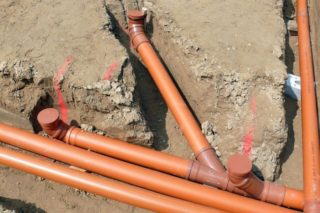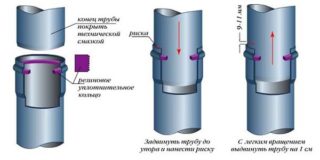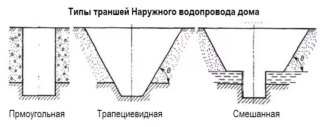PVC pipe with a diameter of 200 mm is used to create an external sewage system. Products of this diameter are painted red, since they are mounted only outside the building and go deep into the ground. Orange pipes are clearly visible on dark soil. They are able to withstand low temperatures and high ground pressure.
Advantages and disadvantages of 200mm pipes

Pipe sections with a cross section of 200 mm are considered to be one of the most durable plastic systems. Their main advantages:
- Rigid piping walls to hold high pressure both outside and inside.
- Long service life due to resistance to rust.
- Easy to install due to the low weight of the structure.
- Resistance to temperature extremes.
- Resistant to aggressive chemicals.
- Low coefficient of linear expansion, which contributes to maintaining the integrity of the pipeline even during freezing.
Pipes with a section of 200 mm can withstand a large thickness of the soil layer, therefore they are used to equip an external sewage system in harsh climatic conditions. The pipeline can be laid to a depth greater than the freezing level.
Due to the high smoothness of the walls, dirt does not adhere to the inner surface of the pipe. As a result, there is no need for additional work to clean up the line, which reduces operating costs. Prices for plastic sewer pipes made of polyvinyl chloride with a diameter of 200 mm start at 500 rubles per running meter.
The matrix base of the pipe is usually unplasticized polyvinyl chloride (UPVC), a polymer obtained from vinyl chloride that does not contain plasticizers. The material has the following qualities:
- fire resistance;
- frost resistance;
- low melting point.
It is a dielectric, non-flammable, rather hard.
Nevertheless, PVC sewer pipe sections are subject to deformation if the temperature of the sewer rises to 70 degrees Celsius. They are also destroyed by organic solvents if they are drained into the sewer line. Under strong mechanical stress or fracture, the pipe may break due to slight elasticity.
If such risks are assumed, it is better to install external polypropylene or polyethylene pipes. The former are able to withstand the influence of higher temperatures. Polyethylene pipelines do not freeze, they are flexible and durable. They easily regain their shape in the event of minor deformations. The cost of 200 mm paper made of polypropylene or polyethylene is higher. In the first case, it starts from 600 rubles per running meter, in the second - from 900 rubles.
Corrugated pipes with a smooth inner surface and an outer dense shell are distinguished by increased characteristics of strength and flexibility. Such products with a section of 200 mm are made of different types of plastic. The price of PVC corrugated pipes is higher than conventional ones. For example, two-layer corrugated products "Korsis" of this diameter cost 926 rubles per running meter.
Specifications

Pipe sections with a diameter of 200 mm, used in external sewer lines, are produced by the method of three-layer co-extrusion of polyvinyl chloride.They are made with a wall having an inner foam layer.
When choosing a pipeline, the ring stiffness indicator is taken into account - the highest load value at which the vertical section deviates by a maximum of four percent. Lateral rebound is not taken into account in this case.
Stiffness class of 200 mm pipes - SN 4. If necessary, it is possible to use pipe sections of class SN 2, SN 8. The standard length is 7 or 8 m.
According to the method of use, the hoses are divided into pressure and non-pressure. The first type is used in sewage systems under pressure, that is, with the forced movement of wastewater. The second is chosen for gravity-flow networks.
The requirements for pipe products for an external sewage system depend on the configuration of the pipeline, as well as the type and volume of wastewater. The main indicators that are taken into account when choosing pipes are:
- resistance to static and dynamic influences;
- resistance to deformation under the weight of the soil over the pipeline;
- no displacement at the connecting sections, leading to depressurization due to the movement of groundwater;
- resistance to damage from loads of passing vehicles and pedestrians.
The wall thickness is designed and selected in accordance with the pipe section. This indicator affects the permissible depth of pipe sections.
For a channel with a section of 200 mm with a wall thickness of 3.9 mm, the maximum depth of the channel is four meters. Pipes with walls from 4.9 mm can be buried by 6 m, more than 5.9 mm - by 8 m.
Installation features
When installing the pipeline, draw up a plan in advance indicating the location of structural elements on the site. Consider the minimum distance from the house to the VOC - 50 m. Decide on the location of the septic tank, cesspool, drainage well. Purchase the necessary materials, taking into account the cross-section of the pipes.
Steps for installing a 200 mm pipeline:
- In accordance with the previously drawn up plan, dig the required number of ditches, in width exceeding the cross-section of the pipes.
- Create a sand and gravel cushion at the bottom of the trench and then lay a layer of geotextile.
- Connect the pipe sections and lay the pipe in the trench. Minimizing the turning and winding sections of the line will improve the tightness and reduce the risk of deposit build-up. During installation, fitting elements are used made of a material similar to the segments to be joined.
Bury the trench in the reverse order. One should not forget about the arrangement of inspection wells at the points of turns in the direction of the highway, significant differences in height. They are also equipped on flat areas - every 6–12 m. After the hydraulic tests have been carried out, the sewage pipeline can be insulated.
Connecting pipe sections

When installing plumbing and sewerage plastic pipelines, the sections of the line are usually connected in a socket way. The purchase of products with sockets greatly simplifies the installation. The distribution of the network is carried out due to the fact that the smooth ends of others are inserted into the sockets of some pipes. The increase in waterproofing qualities is carried out by means of rubber sealing elements. Often they are already constructively provided for in socket products.
If the pipe is manufactured without a sealant, the best option to protect the joint is to use a plumbing sealant. It is applied in an even layer on the smooth end of the pipe section. The quality of the connection can be improved by pre-processing the articulated areas with sandpaper.
After applying the sealing compound, the end of the pipe is inserted into the socket of the other until it stops, then pushed back by 10-15 millimeters, pressed.The presence of a gap allows you to prevent deformation of the pipeline during temperature extremes.
After the installation is complete, it is necessary that the pipe end enter the socket for at least four centimeters. The installation of thermal insulation allows to exclude the possibility of a line accident and protect it from freezing. Installation of insulation materials and a heating cable is carried out only after hydraulic tests - a ten-minute injection of water flow into the pipes.
Red plastic sewer pipe is used in household sewage networks of buildings for various purposes. In addition, it is excellent for plumbing, drainage and stormwater systems. For high-quality operation, it is required to adhere to the assembly technology at all stages and obligatory hydraulic tests to check the tightness of the line joints. All this will ensure a long service life of the sewer network.









